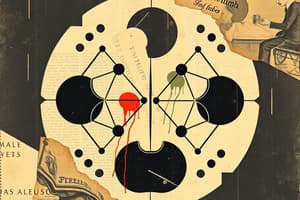Podcast
Questions and Answers
What type of cells undergo meiosis?
What type of cells undergo meiosis?
- Diploid cells
- Sex cells (correct)
- All types of cells
- Somatic cells
What is the primary purpose of mitosis?
What is the primary purpose of mitosis?
- Production of gametes
- Reduction of chromosome number
- Cell growth and repair (correct)
- Genetic variation
Which process results in daughter cells that are genetically identical to the parent cell?
Which process results in daughter cells that are genetically identical to the parent cell?
- Mitosis (correct)
- Nondisjunction
- Crossing over
- Meiosis
During which stage of mitosis do chromosomes align at the cell's equatorial plane?
During which stage of mitosis do chromosomes align at the cell's equatorial plane?
What is the result of nondisjunction during meiosis?
What is the result of nondisjunction during meiosis?
What distinguishes meiosis from mitosis in terms of chromosome number in the resulting daughter cells?
What distinguishes meiosis from mitosis in terms of chromosome number in the resulting daughter cells?
Which stage of the cell cycle typically precedes mitosis?
Which stage of the cell cycle typically precedes mitosis?
What is the role of mRNA in protein synthesis?
What is the role of mRNA in protein synthesis?
Which RNA type is primarily responsible for linking amino acids during protein synthesis?
Which RNA type is primarily responsible for linking amino acids during protein synthesis?
Which of the following accurately describes transcription?
Which of the following accurately describes transcription?
What is the primary function of tRNA in protein synthesis?
What is the primary function of tRNA in protein synthesis?
Which statement best defines a gene?
Which statement best defines a gene?
What is the primary function of the G1 phase in interphase?
What is the primary function of the G1 phase in interphase?
During which phase of mitosis do chromosomes line up at the metaphase plate?
During which phase of mitosis do chromosomes line up at the metaphase plate?
What happens to the nuclear envelope during prophase?
What happens to the nuclear envelope during prophase?
What type of cells carry two sets of each chromosome?
What type of cells carry two sets of each chromosome?
What structure forms during prophase to help separate chromosomes during cell division?
What structure forms during prophase to help separate chromosomes during cell division?
How many hours is the entire mitotic process estimated to take?
How many hours is the entire mitotic process estimated to take?
What is the outcome of anaphase?
What is the outcome of anaphase?
Which of the following phases involves the unwinding of chromosomes back into chromatin?
Which of the following phases involves the unwinding of chromosomes back into chromatin?
What is the composition of human chromosomes?
What is the composition of human chromosomes?
What process results in the creation of a sporophyte from gametes?
What process results in the creation of a sporophyte from gametes?
Which of the following accurately defines the term 'phenotype'?
Which of the following accurately defines the term 'phenotype'?
What type of reproduction involves the development of offspring from a portion of the parent organism?
What type of reproduction involves the development of offspring from a portion of the parent organism?
What distinguishes a sporophyte from a gametophyte?
What distinguishes a sporophyte from a gametophyte?
Which of the following is NOT a type of asexual reproduction mentioned?
Which of the following is NOT a type of asexual reproduction mentioned?
What term describes the different versions of the same gene?
What term describes the different versions of the same gene?
What is the main function of mitosis in asexual reproduction?
What is the main function of mitosis in asexual reproduction?
In Mendelian genetics, what does the term 'genotype' refer to?
In Mendelian genetics, what does the term 'genotype' refer to?
Which method of asexual reproduction allows for the creation of a complete organism from an unfertilized egg?
Which method of asexual reproduction allows for the creation of a complete organism from an unfertilized egg?
Which process is primarily responsible for generating genetic variation in eukaryotic organisms?
Which process is primarily responsible for generating genetic variation in eukaryotic organisms?
What defines a dominant allele?
What defines a dominant allele?
Which genotype represents a homozygous recessive individual?
Which genotype represents a homozygous recessive individual?
In a monohybrid cross between Tt and tt, what is the phenotypic ratio of the offspring?
In a monohybrid cross between Tt and tt, what is the phenotypic ratio of the offspring?
Which statement accurately describes Mendel's Law of Segregation?
Which statement accurately describes Mendel's Law of Segregation?
If a man with genotype Bb and a woman with genotype bb have children, what is the probability of having a child with brachydactyly?
If a man with genotype Bb and a woman with genotype bb have children, what is the probability of having a child with brachydactyly?
Which result occurs from a heterozygous x homozygous recessive cross?
Which result occurs from a heterozygous x homozygous recessive cross?
What is the expected genotypic ratio from a Tt x Tt cross?
What is the expected genotypic ratio from a Tt x Tt cross?
What does Mendel's Law of Independent Assortment state?
What does Mendel's Law of Independent Assortment state?
In the context of inheritance, what does the term 'gene pool' refer to?
In the context of inheritance, what does the term 'gene pool' refer to?
Which of the following best describes a heterozygous individual?
Which of the following best describes a heterozygous individual?
Flashcards
Cell Cycle
Cell Cycle
The sequence of events that a cell goes through from its formation to its division.
Interphase
Interphase
The period in the cell cycle when the cell is not dividing.
Mitosis
Mitosis
The division of the nucleus of a cell, resulting in two daughter nuclei.
Cytokinesis
Cytokinesis
Signup and view all the flashcards
Meiosis
Meiosis
Signup and view all the flashcards
Crossing Over
Crossing Over
Signup and view all the flashcards
Spermatogenesis
Spermatogenesis
Signup and view all the flashcards
G1 Phase
G1 Phase
Signup and view all the flashcards
S Phase
S Phase
Signup and view all the flashcards
G2 Phase
G2 Phase
Signup and view all the flashcards
Chromatin
Chromatin
Signup and view all the flashcards
Prophase
Prophase
Signup and view all the flashcards
Metaphase
Metaphase
Signup and view all the flashcards
Anaphase
Anaphase
Signup and view all the flashcards
Telophase
Telophase
Signup and view all the flashcards
What is a gene?
What is a gene?
Signup and view all the flashcards
Transcription
Transcription
Signup and view all the flashcards
Messenger RNA (mRNA)
Messenger RNA (mRNA)
Signup and view all the flashcards
Translation
Translation
Signup and view all the flashcards
Transfer RNA (tRNA)
Transfer RNA (tRNA)
Signup and view all the flashcards
Gene Pool
Gene Pool
Signup and view all the flashcards
Dominant Allele
Dominant Allele
Signup and view all the flashcards
Recessive Allele
Recessive Allele
Signup and view all the flashcards
Homozygous
Homozygous
Signup and view all the flashcards
Heterozygous
Heterozygous
Signup and view all the flashcards
Monohybrid Cross
Monohybrid Cross
Signup and view all the flashcards
P Generation
P Generation
Signup and view all the flashcards
F1 Generation
F1 Generation
Signup and view all the flashcards
F2 Generation
F2 Generation
Signup and view all the flashcards
Homozygous Dominant
Homozygous Dominant
Signup and view all the flashcards
Sporophyte
Sporophyte
Signup and view all the flashcards
Gametophyte
Gametophyte
Signup and view all the flashcards
Fertilization
Fertilization
Signup and view all the flashcards
Asexual Reproduction
Asexual Reproduction
Signup and view all the flashcards
Budding
Budding
Signup and view all the flashcards
Fragmentation
Fragmentation
Signup and view all the flashcards
Parthenogenesis
Parthenogenesis
Signup and view all the flashcards
Genotype
Genotype
Signup and view all the flashcards
Phenotype
Phenotype
Signup and view all the flashcards
Alleles
Alleles
Signup and view all the flashcards
Study Notes
Cell Division, Genetics and Molecular Biology
- Exam comprises ~40% of the diploma.
- 24 questions approximately.
Cell Division
- Mitosis: 2 divisions.
- Meiosis: 3 divisions.
- Non-disjunction: 1 division.
- Life Cycles: 1 division.
- Mitosis (PMAT): Prophase, Metaphase, Anaphase, and Telophase.
- Chromosome significance: Different chromosome numbers in somatic (body) vs. sex cells (diploid vs. haploid).
- Cell cycle: Interphase (G1, S, and G2), Mitosis (PMAT), and Cytokinesis.
- Meiosis: Spermatogenesis & Oogenesis. Importance of chromosome number reduction.
- Mitosis & Meiosis comparison: Their processes, crossing-over, and nondisjunction roles in inheritance & development.
- Offspring types: Comparing fraternal & identical offspring.
- Human Karyotypes: Interpretation of models.
- Stages of Mitosis from diagrams/images
- Duration calculation of each mitosis stage.
Mendelian Genetics
- Crosses: 4-5 divisions.
- Pedigree: 1 division.
- Inheritance mode: What-if scenarios.
- Genotype: Describes the alleles present.
- Phenotype: Describes visible traits
- Gene concepts: Genes (heritable sections of DNA – protein coding/non-protein coding), Alleles (variants of a gene).
- Human traits: Example: Brachydactyly (dominant), normal length fingers (recessive).
- Homozygous: Two copies of the same allele (BB, bb).
- Heterozygous: Two different alleles (Bb).
Molecular Genetics
- DNA Replication: 2 divisions.
- Protein Synthesis: 3 divisions.
- Recombination: 1 division; what-if scenarios.
- Chromosomal Mapping: 1 division; examples.
- DNA structure: Deoxyribonucleic acid; nucleotides (adenine, thymine, guanine, cytosine).
- DNA location: Nucleus, mitochondria, and chloroplasts.
- Semi-conservative replication: Each strand serves as a template.
- Transcription steps (DNA → mRNA): Initiation, elongation, and termination.
- Translation steps (mRNA → protein): Initiation, elongation, and termination.
Additional Topics
- Asexual Reproduction: Budding, fragmentation, and parthenogenesis.
- Alternation of Generations: Plant life cycles (sporophyte, gametophyte).
- Random fertilization: Source of genetic variation.
- Nondisjunction: Errors in meiosis; examples (Trisomy 21).
- Human Genome Project: Timeline and significance.
- Multiple alleles: Example: Eye color in Drosophila
- Modes of inheritance: Incomplete dominance, codominance, X-linked traits, and other special cases.
- Pedigrees: Family history charts used to understand inheritance patterns.
- PCR (Polymerase Chain Reaction): Technique used to amplify specific DNA segments.
- Gel Electrophoresis: Technique to separate DNA fragments based on size.
- Applications of recombinant DNA (rDNA) technology: Agriculture, pharmaceuticals, and gene therapy.
- Blood typing: Codominance example.
- Chromosome Mapping: Determination by recombination frequency.
- Genotypes and phenotypes.
Studying That Suits You
Use AI to generate personalized quizzes and flashcards to suit your learning preferences.




